COYOTE BEHAVIOR
This is the second in a series of question and answer sessions with my friend Scott Huber, a long time predator control specialist. The first part of our discussion related to coyote basic instincts can be found here: https://coyotestuff.com/coyote-basic-instincts-a-coyote-is-a-coyote/
In this, the second installment, I’m asking Scott to elaborate on coyote behavior and how we can apply our knowledge of it to successful coyote hunting.
DAA: Scott, we talked about coyote instincts last time, the constants that make a coyote a coyote. So now I’d like to ask you about coyote behavior. Each one is an individual, it’s behavior shaped by its environment and life experience. Can you talk about some of the variables involved and how individual coyote behavior is shaped?
SH: When ADC men who work with coyotes 365 days out of the year get together for a b.s. session, most of the coyote conversation centers around coyote behavior.
The basic instincts:
- Food
- Territory
- Social
- Maternal
- Survival
- Reproduction
Hope I didn’t forget one.
It doesn’t matter where they are, coyotes will eat, they will be somewhat territorial, they will breed, they will raise pups, they will do what they have to to survive, and they will be attracted to their own kind.
Those are the constants!
Sounds pretty basic doesn’t it?
From that point on, coyotes will adapt this behavior to fit their environment and that’s where it can get complicated.
The food sources will change. You have to understand this in the area you hunt.
Territorial instincts vary seasonally, they vary based on coyote population, and they can vary based on prey availability. More prey can = less competition for prey. More coyotes can = less territorial responses. Coyote territories can vary in size and shape depending on habitat, prey, and food availability.
Social aspects can vary depending on the coyote population in the area. A lone drifting yearling in desolate country is going to respond differently to one of it’s own kind than a pup coyote in South Texas.
Maternal instincts are pretty much a given.
Survival behavior will vary greatly from area to area based on habitat, coyote population, prey availability, human disturbance, hunting pressure. There is no end to the differences in how coyote survival behavior will vary from area to area. This topic is endless.
Reproduction is pretty constant. You should know when coyotes are mating (Jan.), when they are breeding (Feb.), and when they are picking out their den sites (Mar.). Their response will vary depending on THEIR AGE, and THE TIME OF YEAR.
Dispersing pups usually do not react the same way to coyote vocalizations as the territorial adults do. YOU HAVE TO KNOW THE DIFFERENCE IN AGES TO UNDERSTAND IT.
You can’t just talk about how a coyote reacts, you have to break it down by age to try to better understand it.
A coyote’s environment will change seasonally, it will change geographically from area to area, and it will change based on changing human activity.
A coyote that has been run around for three weeks during deer season is going to be a different coyote than before deer season.
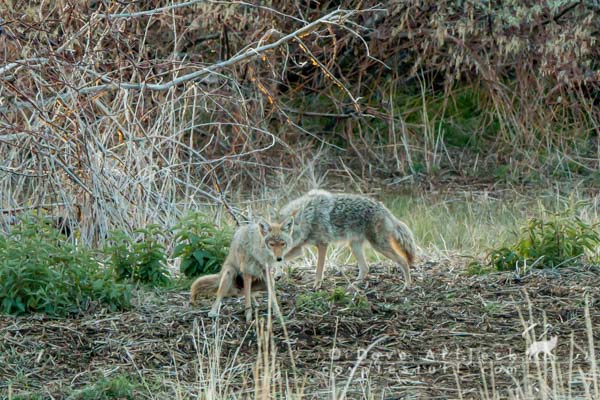
IT’S IMPERATIVE THAT A SUCCESSFUL CALLER UNDERSTAND THESE CHANGES AND CHANGE WITH THEM.
- What are they eating RIGHT NOW?
- Where are they getting it?
- How often is it available?
- How accessible is it?
- Is there water available?
- How does the temperature affect their needs for water?
- What is the coyote population in the area?
- What is the age of the coyote you just shot?
- Does it’s age help you to understand it’s behavior in approaching the call?
- Do coyotes vocalize in the area?
- If not, is it because every time they do they have a pack of dogs chasing them?
- Another conditioned response?
- When are they moving?
- Where are they going to?
- Where are they staying?
- Are they coming back?
- Is there a weather system moving in?
- Is there a weather system moving out?
- What is the hunting pressure in the area?
- What are they avoiding?
- What poses a threat?
- What doesn’t pose a threat?

YOU HAVE TO UNDERSTAND WHAT THEY ARE DOING AND WHY THEY ARE DOING IT AT THAT PLACE AT THAT TIME!
DAA: That’s a lot to digest! But I bet a lot of readers are going “Aha!” right now as they recognize how things they have seen fit into this framework of the big picture.
I guess that is part of why I love coyote hunting though. The challenge is always changing. What works in one place one day doesn’t work on another day in another place. I have seen many of my good calling areas change drastically with development and exponentially increased human activity of all kinds including direct hunting pressure on coyotes. These areas still hold coyote, but those coyotes don’t respond to the same calls in the same places, at the same times, in the same way they used to. Coyotes can still be called in some of those spots but to be successful requires a radically different strategy than it used to. The coyote adapts, so must we.
Scott, would you talk about how you have seen these variables play out in the field?
SH: It’s so comical to see the guys that think they have coyotes figured out go to a new area and fall flat on their face. I had to experience it for myself to appreciate it.
A woody draw in the Dakotas is different than the sandhills of Nebraska is different than an ocean of sage brush in Wyoming is different than the timbered mountains of Colorado is different than a timbered or brushy river bottom in Minnesota, is different than the mesquite in Texas is different than the cactus in Arizona is different than the junipers of New Mexico is different than the rocky ground in Southern Utah.
Changes of habitat require changes of attitude and changes in how you hunt.
I remember calling the San Juan river near the four corners monument. I expected the coyotes to come from the river bottoms when they were up in the rocks. They hunted the river bottoms at night and stayed in the rocks during the day. The river bottoms were used by people during the day. Coyote had visibility in the rocks. HUMBLING!
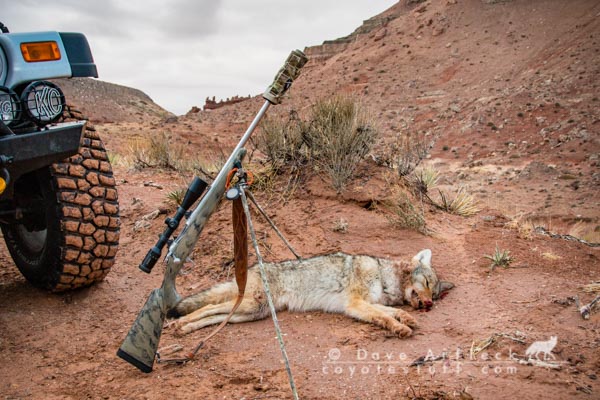
The only way you can ever achieve the highest level of coyote calling success is to understand the coyotes in your area at that time of year.
Most beginners are wanting the secrets to success. The secrets to success is to understand what the coyotes in your area are doing, when they are doing it, and why they are doing it.
Nobody can tell you that. You have to learn it on your own because it will vary so much and nobody can tell you about your particular area.
I can’t give you the answers I can only tell you what to look for.
Let me give you another trapping example of what I am talking about. All the coyote trapping instructors will tell you to set on fresh sign. That’s good advice but far from experienced advice.
All that tells you is that a coyote WAS there. It doesn’t tell you anything about whether he will be back. Here’s what will tell you something and YES this is applicable to calling.
What Coyote Sign Is Trying To Tell You
- A fresh track tells you a coyote has been there.
- The freshness and direction of that track tells you when he was there and where he was going.
- Fresh tracks going both directions indicates an area that is being used to enter and leave the area. That’s worth a lot more than a track going one way.
- A dropping indicates a place where a coyote naturally feels comfortable enough to stall out time. Where they stall out time they will more readily work a set.
- Coyote tracks of different ages coming and going indicate that coyotes have been using this area for quite some time.
- Coyote tracks of different sizes indicate family groups.
- Droppings of different ages show that coyotes have stalled out time in this spot numerous times over the years.
- Droppings of different contents of different ages tell you that coyotes have been using this location for more reasons than obtaining one source of food.
THE VERY BEST CALLING AND TRAPPING LOCATIONS WILL HAVE TRACKS COMING AND GOING, TRACKS OF DIFFERENT SIZES, TRACKS OF DIFFERENT AGES, DROPPINGS OF DIFFERENT AGES, AND DROPPINGS OF DIFFERENT CONTENTS.
DAA: That is some rock solid advice that can absolutely be applied to calling. You told me pretty much exactly that in regards to coyote tracks about 15 years ago and I have profited from it ever since. I learned to stop spending so much time in areas with marginal sign and started really slowing down, paying close attention to the details and really working the areas with the kind of sign you describe. Made better use of my limited hunting time. Put more coyotes in the truck.
Exactly the kind of stuff a new caller can really use to be more successful.
You’ve outlined an excellent framework for considering the variables in a logical, methodical manner and I’ve no doubt many readers are thinking of ways they can apply it to their own hunting as they read this and think of how things they have seen relate to the big picture.
I’ll relate how I interpreted many of these variables on a hunt a few days ago, just to try and illustrate how all of this can really be applied to improve success.
Putting It All Together for Success In The Field
To set the scene, just a few days ago, I was calling a great big high desert valley, about 150 square miles total, with no paved roads or permanent inhabitants but many dirt roads and some structures that get used on a seasonal basis. I hadn’t been there for a couple of years and don’t know the valley that well. Arriving before dawn and listening to howls at first light, I knew there were coyotes down in the thick brush in the flat bottom of the valley.
So I went down in there for a look. On my way down into the flats, I noted not much coyote sign around the edges and in the upper levels of the valley. But once down in the flats in the thick brush I found a lot of coyote droppings and a lot of coyote track. Both droppings and track of different ages. Track, of different sizes. Track going in every direction, much of it not in a straight line but weaving, back and forth, standing still in spots etc., not just tracks in the road travelling through. But tracks of coyotes spending time and hunting.
The amount of fresh droppings and track told me there were quite a few coyotes spending a good amount of time right there down in the thick brush flats. I was also seeing a lot of rabbits and rabbit sign down in there. Looking at the fresh coyote droppings, I could see these coyotes were eating those rabbits.
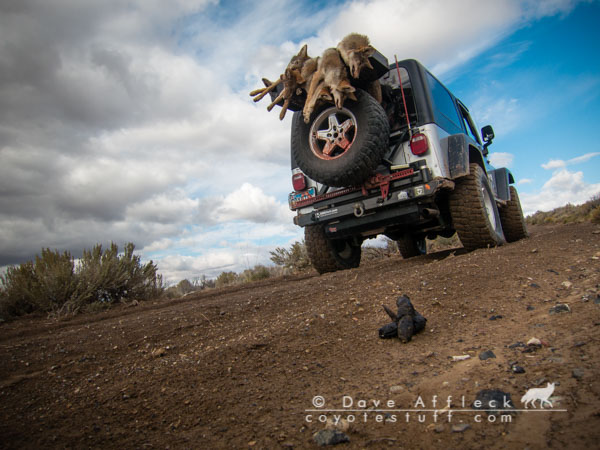
I figured the coyotes are simply living right there in the thick brush with the rabbits and not travelling back and forth to reach them. Water was more or less everywhere in the form of puddles in depressions in the alkaline-clay soil, some of the puddles as big as half an acre. Food, water and dense security cover all in one place – and about 120 contiguous square miles of it. I simply didn’t see why those coyotes would be going anywhere and I don’t think they were. They were spending their days and nights right there where the food, water and cover were. And judging by the amount of sign, a decent number of coyotes too.
As far as what I thought the coyotes of that valley would see as a threat or be avoiding… To me, it was obviously the main dirt roads that mostly circled the perimeter of the valley. Those road see a fair amount of traffic. A high percentage of that traffic will take a shot at any coyote they see. I know that other callers hunt this valley besides me and the obvious, easy stands to make area mostly near those higher traffic dirt roads. So, to me, I’m thinking if those coyotes are going to avoid anything, it’s those high traffic areas. The few dirt roads down in the thick flat bottom of the valley showed little sgns of use. Not much traffic. At the same time, my experience with coyotes in Utah in general, is that they tend to feel pretty secure in the thick brush.
So, to me it seemed obvious, the coyotes were hanging in the thick brush on the flat valley floor where they were eating rabbits and probably not travelling anywhere. They probably felt secure there in that brush and weren’t likely getting much direct pressure down in there.
So, time to grab the shotgun and go make some jackrabbit distress sound in the brush.
But… Here is where I think the small details start to really show and become important. Knowing the coyotes are out in the flats is great. But knowing exactly which parts of the flats to hunt is even better.
The soil type on the valley floor was not all the same or consistent. In some parts, the ground was like dry lake bed alkali, a white clay type soil without much rock and on which water will often puddle until it evaporates rather than sink in. In other places the soil was gravelly and rocky, water sinks in and runs off quickly in that type of desert soil. The vegetation, was pretty consistent throughout both soil types with greasewood growing thick on one end of the valley and gradually giving way to thick tall sage on the other end, but all of it growing pretty much the same in both soil types.
So, I had sage, greasewood, alkaline/clay soil and rocky gravelly soil.
Well… The rabbits and the rabbit sign were much heavier in the alkaline soil and greaswood areas than the gravelly soil or sage areas. So was the coyote sign. Mind you, the two soil types were interspersed. So you could be driving on a two track and have the alkaline for half a mile than a half mile of gravel then another mile of alkaline and two miles of gravel and so on. And it took paying fairly close attention to the sign to really notice that there was actually a lot more coyote droppings and rabbits in the alkaline areas than the gravel. I think it would have been pretty easy to miss that clue, under the circumstances.
But as the day progressed, it did become clear that the alkaline greasewood areas were holding a lot more animals than the gravelly areas or the sage. So I concentrated my efforst on locating stands in the alkaline/greasewood zones where the sign was heaviest and didn’t spend much time on the gravel or sage ares where there was less sign.
This was almost on a “micro” level. The valley held a lot of coyotes. They were in the thick stuff down on the flats. But they were not evenly distributed in the thick stuff on the flats. The coyotes were eating and keying on rabbits and the rabbits were very clearly concentrated in the small areas of alkaline and greasewood.
I know jack rabbits like to eat greasewood leaves. So no surprise they should be concentrated where the greasewood was growing. But the greasewood was growing just as much in the gravel soil areas as the alkaline dry lake bed clay. My best guess? The rabbits like the heavier salt content/taste of the food growing in the more alkaline soil. At least at that time and in that place. And the coyotes were simply keying in on where the rabbits were concentrated.

Whew! I just wrote half a book talking about a very small detail. But, my hunting partner and I had a really good day of calling in that valley and we were both convinced that noticing those small details and concentrating our efforts on those particular areas really paid off for us.
I could write another half of a book about the ages of the coyotes we killed, how they approached the caller, how they responded to vocalizations and how that all played into how I approached the hunting and calling that day, but I’ve made this too long already I’m afraid.
The moral of all this is simply that I really believe in what you are saying Scott! Really thinking about these variables you list, really paying attention to the details of the habitat and conditions and weather and food availability and human disturbance in the area you are hunting, trying to fit it all together and formulate a calling strategy that uses this information, it really does increase success.
Thanks again for taking the time to share your insights with us Scott!
– Dave Affleck
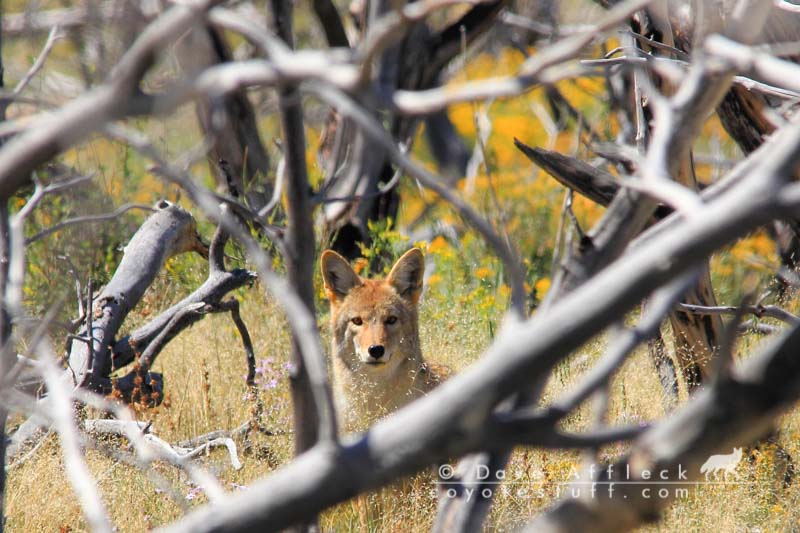
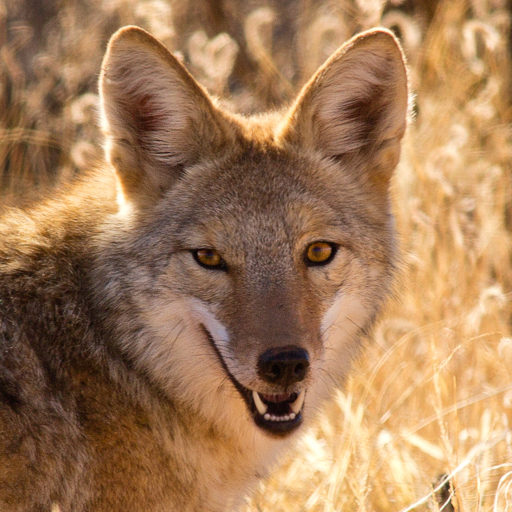
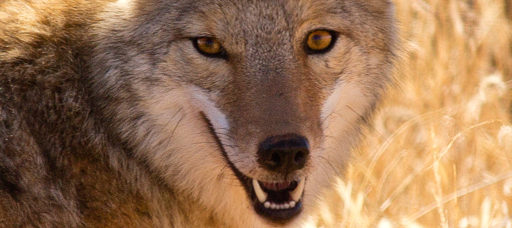
Interesting, I have never analyzed it down to soil type growing what rabbits like best. Most every coyote I shoot I check its sex first and then its teeth for age. NW Oklahoma is pretty much surveyed down into 640 acre (1 square mile) sections, privately owned. From what I have seen here in Ok is their core area, defended territory is smaller than in wide open areas with not as many man made boundaries.
I had a hard time paying attention in school, but when an ADC guy or old time trapper talks, I listen;)
Jeremy, I was just trying to think of why there would be so many more animals in the alkaline than the gravelly spots and salt/minerals in the greasewood was the best I could come up with. It is just a guess though. But for sure, that day, that’s where the animals were.
I’m enjoying reading your articles, looking forward to more. Thanks brian..
Thank you Brian!
Very informative Dave, thanks!
Thanks for reading and glad you enjoyed it Rob.
Awsome as usual Dave! Hope you keep this site rollin’, we love it!
Thanks! Always appreciate the comments and kind words.
Wish you had touched on the change in weather and how it effects the behavior. I enjoyed what you wrote, I’m trying to figure out just how changing weather, cold to very warm in a matter of a few days.
I think it’s much like any other variable. In that, the interaction with other variables makes it hard to generalize. Each situation being so specific. No doubt about it though, weather can play a big role in the daily habits and actions of a coyote.
As I am new to coyote hunting and I am trying to absorb as much knowledge about coyote hunting and coyote behavior as possible in my attempt to try and understand more about what makes these predators tick, I appreciate forums such as this and the articles/posts on your website. I know even seasoned pros are constantly learning new things about coyotes and since I am on the steep side of the learning curve, your informative website has provided a great deal of information. I reside in SW MT and as we are currently in the middle of the breeding season (early February) what type call sequences do you think provide the best chances of eliciting a response? My hunch is to go with coyote vocalizations but I wanted to hear your thoughts. Thanks.
Paul, I personally am done hunting coyote for the year. I usually hang it up about this time. The conventional wisdom is certainly that vocalizations are the way to go this time of year and I can’t disagree. Although, they do still kill and they do still eat and I have had success with straight prey distress at all times of year as well. But I think in general, this time of year, vocalizations and patience are your best bet.